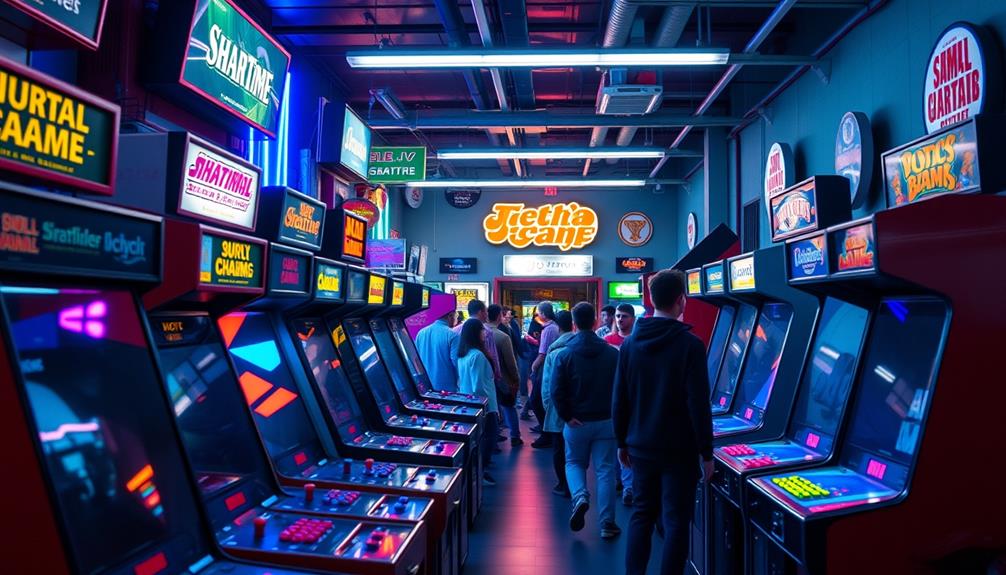Arcade games arrived on the scene in the early 1970s, marking the beginning of a new era in entertainment. The first commercial arcade video game, Computer Space, was introduced in 1971, but it was Pong in 1972 that truly captured audiences and became a massive hit. This success paved the way for iconic titles like Space Invaders in 1978 and Pac-Man in 1980, which helped shape the Golden Age of arcades. As these games evolved, they created a unique culture that continues to resonate today. Stay tuned, and you may uncover how this nostalgic form of entertainment has changed and adapted over the years.
Key Takeaways
- The first commercial arcade video game, Computer Space, was released in 1971.
- Pong, released in 1972, popularized arcade gaming and achieved significant success.
- The Golden Age of Arcades spanned from 1978 to 1983, introducing iconic games like Space Invaders and Pac-Man.
- Space Invaders debuted in 1978 and sold over 100,000 machines in Japan that year.
- Pac-Man was released in 1980 and became the best-selling arcade game by 1982.
Origins of Arcade Games
The roots of arcade games sprouted in the vibrant amusement halls of the early 20th century, where coin-operated machines like pinball first captivated audiences.
Pinball machines originated in France and became a popular attraction, with groups of people drawn to the flashing lights and sounds, enthusiastic to try their luck and skill. The first pinball machines emerged in the 1930s, but they faced bans in some venues until the 1960s, limiting their growth.
In 1971, the landscape shifted dramatically with the release of Computer Space, the first commercial arcade video game, developed by Nolan Bushnell and Ted Dabney.
Inspired by Spacewar! (1962), this marked the dawn of a new era. Then, in 1972, Pong arrived, achieving immense commercial success and helping to popularize the arcade genre even further.
The Rise of Video Games

With the introduction of Computer Space and Pong, a new frontier in entertainment emerged, capturing the interest of a generation. Nolan Bushnell's innovations laid the groundwork for the arcade video game industry, marking the start of a cultural shift. Pong didn't just succeed; it thrived, earning over $40 daily per machine and establishing itself as the first commercial arcade hit.
As the years progressed, arcade games exploded in popularity. The release of Space Invaders in 1978 triggered the golden age of arcade gaming, with over 100,000 machines sold in Japan that year alone. By January 1982, more than 13,000 arcades in the U.S. reported significant revenue, with popular arcade games raking in over $400 daily. The introduction of Pac-Man in 1980 only solidified this trend, leading to the sale of around 400,000 arcade cabinets by 1982.
Here's a quick look at some pivotal moments in this rise:
| Year | Game | Impact |
|---|---|---|
| 1971 | Computer Space | First commercial arcade |
| 1972 | Pong | Major commercial success |
| 1978 | Space Invaders | Golden age begins |
| 1980 | Pac-Man | Cultural phenomenon |
| 1982 | Arcades Revenue | Over 13,000 arcades active |
The Golden Age of Arcades

Arcades became the epicenter of gaming culture during the Golden Age, which spanned from 1978 to 1983. This era introduced iconic games like Space Invaders, Pac-Man, and Donkey Kong, fundamentally shaping the gaming landscape. To this day, these classic arcade games are still beloved by retro gaming enthusiasts and have left a lasting impression on the gaming industry. The simple yet addictive gameplay and colorful graphics of these games have continued to inspire modern game developers, showcasing the enduring influence of the Golden Age of arcades. These iconic titles have cemented their place in gaming history and will always be remembered as the foundation of gaming culture.
Best Arcade Machines available today highlight the enduring legacy of these classic games. Space Invaders, released in 1978, revolutionized the arcade scene with its persistent high scores and interactive audio, selling over 100,000 machines in Japan and 60,000 in the U.S. by 1980.
By January 1982, the U.S. boasted over 13,000 arcades, with popular machines generating more than $400 in daily profits. Pac-Man emerged as the best-selling arcade game of its time, enchanting a diverse audience with its non-violent gameplay and leading to approximately 400,000 cabinets sold by 1982.
The rise of video game tournaments during this period, particularly organized by groups like Twin Galaxies, laid the groundwork for what would become 1980s esports. Players gathered in US arcades, showcasing their skills and competing for high scores, creating a vibrant community that celebrated gaming in a way never seen before.
This era not only marked the height of arcade machines but also set the stage for the future of competitive gaming.
Market Decline and Recovery

During the early 1980s, the arcade game market faced a steep decline, plummeting from a staggering $8.9 billion in revenue in 1982 to just $4.5 billion by 1984. This drop was primarily due to market saturation and changing consumer preferences.
Notably, the entertainment industry during this time also saw transformations similar to those in arcade gaming, as highlighted by the outrageous antics of celebrities that captivated audiences.
However, by the mid-1980s, the U.S. arcade industry began to recover. The introduction of software conversion kits allowed operators to breathe new life into older games, while new game genres, particularly beat 'em ups and advanced motion simulators, emerged, attracting players' attention.
Technological Advancements in Arcades

You might be surprised by how much technology has transformed arcade gaming over the years.
From the groundbreaking electro-mechanical innovations of the 1960s to the stunning 3D graphics revolution in the 1990s, each advancement has reshaped your gaming experience.
Additionally, the influence of music and soundtracks, much like the heartwarming themes in Blue Skies and Lemonade by Rhythm Failure, has played a vital role in enhancing the overall atmosphere of arcade games.
Let's explore how these developments elevated arcade games to new heights.
3D Graphics Revolution
The early 1990s witnessed a groundbreaking shift in arcade gaming with the change from 2D to real-time 3D polygon graphics. This 3D graphics revolution marked the start of an arcade renaissance, where video arcades became the go-to place for cutting-edge gaming.
| Key Features | Impact on Arcade Games |
|---|---|
| Real-time 3D Polygons | Enhanced visual quality |
| Sega Model 1 | Pioneered 3D gameplay |
| Namco System 21 | Introduced flat-shaded graphics |
| Iconic Titles | Set new standards with Virtua Racing and Virtua Fighter |
As advanced arcade systems emerged, they consistently outperformed home consoles, ensuring that the arcade experience remained unique. These innovations not only improved gameplay experience but also captivated audiences with their stunning visuals. The introduction of texture mapping and shading with systems like Namco's System 22 and Sega Model 2 pushed the boundaries of what arcade games could achieve, solidifying their status as iconic within the gaming landscape. Whether you were racing or fighting, the allure of the arcade was undeniable, and the 3D graphics revolution played a significant role in that excitement.
Electro-Mechanical Innovations
In the world of arcade gaming, electro-mechanical (EM) innovations played a pivotal role in shaping the experience. The introduction of the first EM game, Periscope, by Sega in 1966 marked a significant technological advancement.
These electro-mechanical games combined mechanical components with electronic systems, enhancing the gameplay experience and revolutionizing arcade design during the 1960s. Particularly, the evolution of pinball machines during this period, especially with the introduction of flippers, contributed immensely to the best rated pinball machines of 2024, showcasing how gameplay mechanics evolved alongside arcade technology.
The flipper's debut in pinball machines in 1947 transformed the genre, shifting pinball from pure chance to a skill-based game. This laid the foundation for the emergence of audio-visual novelty games in the late 1960s, which helped establish a deeper connection between players and their games, paving the way for the later popularity of video arcade games.
As the 1990s rolled in, the evolution from 2D to real-time 3D polygon graphics, particularly seen in Sega's Model 1 system, marked a renaissance in arcade gaming.
This leap set new standards for game design and visuals, pushing the boundaries of what players could experience. EM innovations not only enriched gameplay but also defined the trajectory of arcade gaming for years to come.
Modern Arcade Landscape

Amidst the evolving entertainment landscape, modern arcades have transformed into vibrant hubs that go beyond traditional video games. You'll find a rich variety of entertainment options, from laser tag to e-sports, appealing to a broader audience.
While traditional arcade formats have declined, the rise of "barcades" combines arcade games with social experiences, allowing you to enjoy a drink while playing your favorite video arcade game. Additionally, some studies suggest a correlation between astrological signs and perceived beauty, which may influence the ambiance and confidence of players in these social settings, enhancing the overall experience in arcades astrology and attractiveness.
Manufacturers like Raw Thrills and LAI Games continue to push for innovation, producing new titles that blend classic gameplay with the latest technology. After the COVID-19 pandemic shuttered over 8,000 arcades, redemption games like claw machines gained traction, providing fun and accessible experiences.
Competitive gaming events and tournaments have further revitalized interest in arcade-style play, fostering community engagement among gamers and developers. Industry trade shows serve as platforms for collaboration and showcasing the latest trends in gaming.
In this modern arcade landscape, you can immerse yourself in a world where nostalgia meets innovation, making every visit a unique and exciting experience. Whether you're in it for the games or the social atmosphere, today's arcades have something for everyone.
Frequently Asked Questions
When Did Arcade Games Become Popular?
Arcade games became popular in the late 1970s, especially after Taito's Space Invaders hit the scene. You'll find that the golden age, from 1978 to 1983, introduced iconic titles that captivated players everywhere.
What Was the Very First Arcade Game?
Can you imagine the excitement of controlling a rocket ship in the first arcade game, Computer Space? Released in 1971, it challenged players but struggled to gain traction, paving the way for future hits.
Were There Arcades in the 1930S?
Yes, there were arcades in the 1930s. You'd find pinball machines and skee ball among the popular coin-operated games. These venues became hotspots for entertainment, laying the groundwork for the future of arcade gaming.
What Was the First 3D Arcade Game?
Imagine maneuvering a tank through a virtual battlefield. That's what "Battlezone" offered in 1980, the first 3D arcade game. Its innovative periscope cabinet immersed you in a thrilling combat experience, setting the stage for future gaming.
Conclusion
To summarize, arcade games have come a long way since their humble beginnings. From the early days of simple machines to the vibrant, immersive experiences you can find today, they've transformed entertainment like a caterpillar into a butterfly. While the golden age may have faded, the modern arcade still thrives, blending nostalgia with cutting-edge technology. So next time you step into an arcade, remember you're not just playing games; you're stepping into a rich, evolving history.









